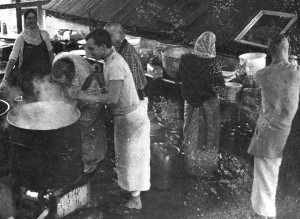New Vrindaban’s Transcendental Throwback Thursday – 03/20/14
New Vrindaban’s Transcendental Throwback Thursday – 03/20/14.
Each week we highlight an earlier era of ISKCON New Vrindaban.
This week’s challenge: Despite a slight blurriness, there are four devotees whose faces are recognizable and two with their backs to the camera. How many can you identify?
Extra Credit: What is the special name of the place they are in?
Post your guesses on the “who, what, when, where & why” in the comment section at the New Vrindaban Facebook Page.
Technical stuff: We share a photo Thursday and confirm known details Sunday. Let’s keep it light and have a bit of fun!
Special request: If you have a photo showing New Vrindaban devotees in action, share it with us and we’ll use it in a future posting.




Follow Up For New Vrindaban’s Transcendental Throwback Thursday – 03/20/14.
Here’s the info we have:
Who, left to right:
Shobhavati (wearing a light colored sari & dark apron)
Bhokta (wearing glasses and peering into the cooking pot)
Advaita (wearing dhoti and apron, stirring the pot)
Sankirtan (wearing plaid shirt, face partially covered),
Kutila (wearing patterned sari & dark sweater)
Kuladri (wearing white dhoti & dark kurta)
What: Cooking in “The Pits.”
When: Circa 1977-78.
Where: Bahulaban, New Vrindaban.
Photographer unknown.
Below is a description shared by Sankirtan prabhu:
“The picture is probably from around 1977-78. I was in the pits from early 1977 to early ’79. By the spring of ‘79 a new kitchen was built on the ground floor of the guest house building. I cooked both breakfast and lunch. That means I had to be out there by 5 AM because breakfast was around 7 (mangala arati at 4). Tejo trained me up in cooking the famed oat water and rice for breakfast. I probably cooked breakfast for about 15 years, but only cooked lunch until we moved up to the new temple building in the early 80’s. The pits were located outside, adjacent to the Deity kitchen with only a tin roof to cover you from the elements. The cooking continued outside all year round. Moving 20 or 30 gallon pots around wasn’t that much of a problem, nor was the cold. The trick was to keep a steady fire going, since all the cooking was done with wood. And if it rained or snowed you would be dealing with wet wood which didn’t give off too much heat but a lot of smoke. In the winter, you would want to get a head start by stacking the kindling and wood in the pits on the previous evening. So when you got out there in the morning the fire would be already to start. The outside of the pots got all blackened from the fire. I had started with a clean, white apron. But after a week it was as black as the pots since I was throwing the pots here and there and carrying them to a sink to be cleaned.”
A remembrance shared by Pitambar:
“Working in the pits was unique and a challenge but usually fun, especially for feasts. Rice and oat water however a little boring. Working with open flames, many of us caught on fire. One time I remember Taru beating me with a potato sack to put out my burning sari. Speaking of the pots, they were extremely difficult to clean. That service was usually assigned to a new devotee. For a while it was Tilakini and me. Often we ran out of soap and in the winter used the ashes from the wood stove to clean them. There are endless pastimes of service in the pits.”
Thanks for participating. Let’s do it again next week!
Special Request: If you have a photo showcasing New Vrindaban residents in action, from the ’70s, ’80s, ’90s and ’00s, please send it to us and we can share it in a future posting.